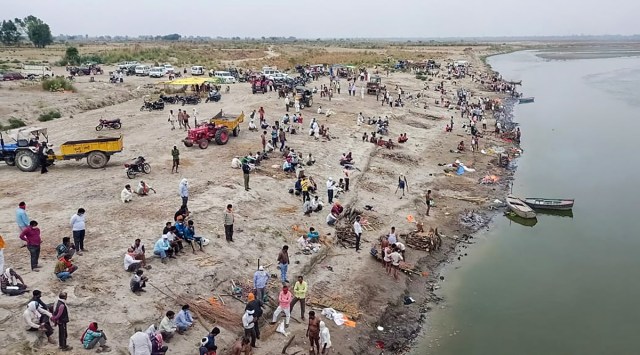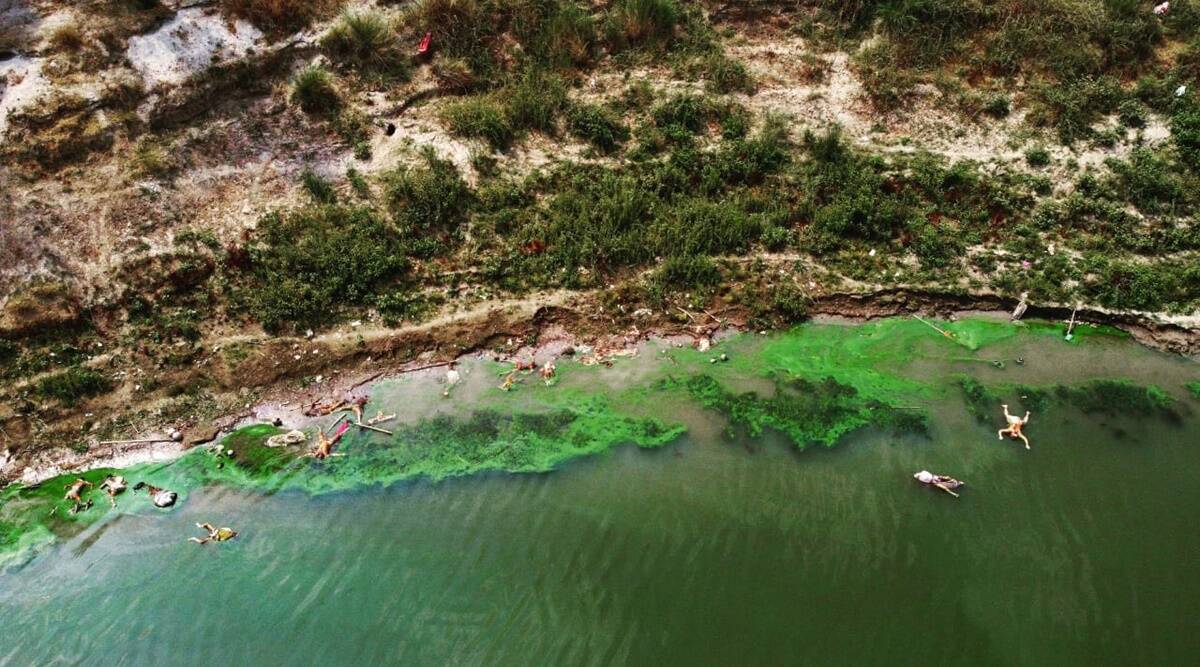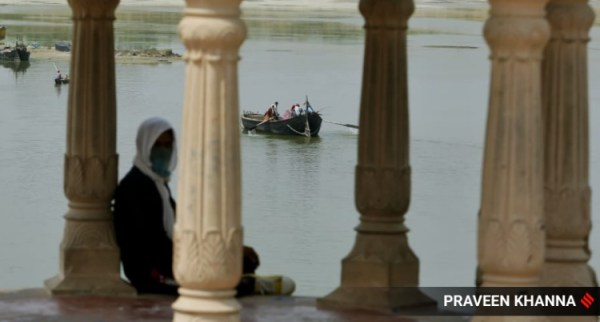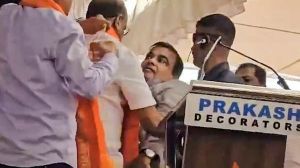- India
- International
Behind bodies found on river banks, a Covid shadow
Interviews with next of kin, officials, eyewitnesses and local residents in Unnao and Ghazipur reveal that behind the bodies lie long-held traditions, deep economic distress and the sudden rush to lay the dead to rest.
 Relatives and family wait to cremate on the banks of River Ganga, in Unnao, Thursday. (PTI)
Relatives and family wait to cremate on the banks of River Ganga, in Unnao, Thursday. (PTI)Days ago, the bodies were in scores, unclaimed, uncounted and unidentified. On Friday, at the Gahmar Ghat in Ghazipur, there were five. Two face down in the sand on the Ganga riverbank; one part submerged, the remaining two in fragments. Not far from here, in Unnao, again on the banks of the Ganga, an estimated 200 bodies were laid bare this week by the shifting sand after a heavy downpour.
These bodies, juxtaposed with images of overflowing cremation and burial grounds, frame a tragic rural postcard from UP and downstream Bihar touched by Covid.
Interviews with next of kin, officials, eyewitnesses and local residents in Unnao and Ghazipur reveal that behind the bodies lie long-held traditions, deep economic distress and the sudden rush to lay the dead to rest — all of this under the shadow of a devastating pandemic that has led to several deaths outside official records.
At the Gahmar Ghat, 7 km from the Bihar border, the district administration, police and local residents have been busy over the last three days, trying to dispose of the bodies, either by cremating them, or by burying them deep in the sand.
“It was a sight that I have never seen before. We used boats to pull the bodies to the shore. The whole air was filled with the stench of death. The Gangaji turns here at Gahmar, so the bodies flowing downstream accumulate here. There could not have been fewer than 80 bodies,” says Kamla Devi Dom, who has worked at the Gahmar Ghat for many years.

 Human corpses float to the Ganga’s surface in Bihar’s Buxar district. (Photo courtesy: Amar Nath Tiwari/Unexplored Adventure)
Human corpses float to the Ganga’s surface in Bihar’s Buxar district. (Photo courtesy: Amar Nath Tiwari/Unexplored Adventure)
Pradeep Kumar, a barber at Baksar Ghat, says that with the second Covid wave, the cost of conducting cremations has shot up. “A pyre that earlier used to cost around Rs 500 now costs around Rs 1,500-Rs 2,000, and the entire process of cremation costs around Rs 10,000,” he says.
“Only around 15 days ago, a local resident was buried in the sand. He was an alcoholic. After the recent rains, the sand got washed away and dogs dug up his body. I see that a lot of people are burying bodies here as they cannot afford to cremate them,” he says.
 Police patrolling Gahmar Ghat, where many bodies were found.
Police patrolling Gahmar Ghat, where many bodies were found.
Motu Kashyap, who buried his father Pyare Lal Friday, said cremation was not an option for him. “After I reached the ghat, I argued with authorities to allow a burial. My father was 87, and died of old age. I am an agricultural worker with five daughters. How will I have money to buy wood, pay the priest and cremate the body?” he says.
Near the river bank on the ghat, The Indian Express found hundreds of burial spots lying exposed after the rains. Karan Singh, a fisherman, said that till a week ago, around 100 bodies used to be carried to the ghat, and more than half of them would be buried. “But now, the district administration has issued clear instructions to stop burials,” he says.
On Friday, the UP government said that the Home Department will deploy the State Disaster Response Force (SDRF) and the Jal Police of PAC for patrolling all the rivers in the state to ensure that bodies are not dumped in rivers.
“Two days ago, we came to know that several bodies have been buried under the sand in Baksar. Burial is a matter of tradition and we are trying our best to convince people to go for cremation,” says Unnao District Magistrate Ravindra Kumar.
 A Family returning to shore in a boat after cremating a body at Gahmar Ghat.
A Family returning to shore in a boat after cremating a body at Gahmar Ghat.
“These things have been happening for a long time. Baksar Ghat is at the district border and has the Chandrika Devi temple. People from Unnao, Fatehpur, Rae Bareli and even Kanpur come here for final rites. Along with this, there is a possibility that the number of bodies coming to the ghat have increased. As far as I have been informed, around 150-200 bodies were found buried at the ghat,” says the DM.
In Ghazipur, during the four hours that The Indian Express spent at Gahmar Ghat, there was a constant stream of officials — Circle Officer, Block Development Officer, SDM Sevrai — each issuing the same instructions. “Make sure nobody puts unburnt bodies in the ghats. They should burn them completely. There is no shortage of wood now,” says Ramesh Maurya, the SDM.
On May 1, Ghazipur had 421 new cases, and a total active caseload of 5,439 with 122 deaths in all. By May 13, official records showed a dip to 249 new cases, and 2,804 active cases with 199 deaths. “Right now, we are doing regular monitoring of the ghats, and making sure that people do not throw bodies in the river directly,” says Maurya.
 At the Gahmar Ghat, 7 km from the Bihar border, the district administration, police and local residents have been busy over the last three days, trying to dispose of the bodies, either by cremating them, or by burying them deep in the sand.
At the Gahmar Ghat, 7 km from the Bihar border, the district administration, police and local residents have been busy over the last three days, trying to dispose of the bodies, either by cremating them, or by burying them deep in the sand.
Police Inspector Hari Narayan Shukla says his teams are patrolling a 25-km stretch, up to the Chausa border in Bihar, to ensure that no bodies are thrown in. “People are afraid of Covid, and don’t want to touch the bodies. There is a shortage of wood, too. There are ghats like this, but villagers also perform the last rites anywhere along the banks. Just this morning, I saw one family trying to sneak off to one side to perform the last rites without burning the body. I brought them here,” says Shukla.
About 200m away, a family of eight stood hunched next to a burning pyre, the fourth to burn at the ghat on Friday. They were from the village of Gohda, and mourning the death of the family matriarch, in her sixties.
In the morning, the sons and nephews, a family of daily wage labourers, took a round of the ghats nearby. “We asked how much it would cost. Normally wood at the ghats is for Rs 600 a quintal, and three quintals are needed to burn a body. Now, we were quoted Rs 1,000 a quintal. On top of that, the money for the Dom, and the ghee, and the rites would have meant Rs 4,500. It is money we did not have. We can only do this because the administration arranged for the wood,” says one of the nephews.
Asked if she died of Covid, her son, quiet till then, had an answer all too common in UP. “How do we know? She was old, so maybe it was her time. But she had fallen ill, like many others in the village.” Her symptoms? “The same… cough, cold, fever.”
Apr 24: Latest News
- 01
- 02
- 03
- 04
- 05







































